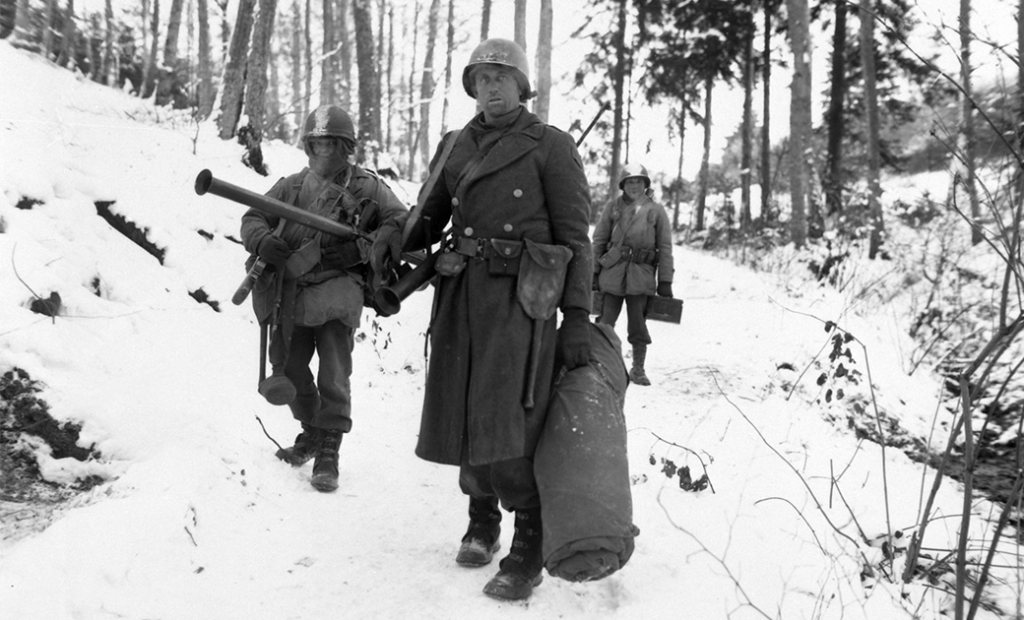
“This is undoubtedly the greatest American battle of the war and will, I believe, be regarded as an ever-famous American victory.” – Sir Winston Churchill, British Prime Minister
On December 16th, 1944, the last major German offensive of World War II began. The Battle of the Bulge, also known as Ardennes Counteroffensive, would last over a month, ultimately ending on January 25th, 1945. Adolf Hitler made one last push against Allied forces on the Western Front after D-Day, with the aim of splitting up these Allied forces in his drive toward Germany.
Early on the morning of December 16th, among the rain and mist, German forces began their attack on American forces stationed across nearly 80 miles of the dense Ardennes Forest. These American forces – just four divisions, inexperienced and already battle-fatigued – faced over 30 German divisions in a surprise attack.
As German forces drove further into the Ardennes, the Allied line looked like a large bulge, giving the battle its famous name. After a day of intense fighting, German forces broke through the American front. Word of massacred soldiers and civilians quickly spread, as did word of German tactics such as changing road signs, spreading misinformation, and even German soldiers disguised as Americans.
In the Belgian town of Bastogne, Allied troops became surrounded by German forces. General Eisenhower sent more American units, including the 101st Airborne Division.
On Christmas Day, 1944, weather conditions finally cleared, allowing air strikes by the Allied Forces. General Dwight D. Eisenhower and Lt. General George S. Patton, Jr. Led the American defense. General Patton and the Third U.S. Army turned their focus to the north and were able to break through the German lines in Bastogne and rescue the troops there.
Although various Allied forces fought in the battle, American soldiers are known for their persistence in their attempts to hold off German forces. Usually isolated and suffering through the extremely cold conditions, American soldiers often didn’t know the larger picture of what was happening in the battle. Still, they did everything they could to slow the German advance, including “delaying armored spearheads with obstinate defenses of vital crossroads, moving or burning critical gasoline stocks to keep them from the fuel-hungry German tanks, or coming up with questions on arcane Americana to stump possible Nazi infiltrators.”
Ultimately, the Allies were able to defeat the German forces, and headed towards Berlin. WWII would officially end just five months later.
In total, it is estimated that over 1 million Allied troops fought in the Battle of the Bulge, including 500,000 Americans. Approximately 19,000 American soldiers were killed in action, with 47,500 wounded and 23,000 missing. The Battle of the Bulge was the largest and bloodiest single battle fought by the United States in WWII. It remains the third-deadliest campaign in American history.
Acknowledging and remembering The Battle of the Bulge is one of the ways we can uphold our mission to Honor our veterans here at NVMM. We also strive to educate our all visitors about key events in American military history, like the Battle of the Bulge, as well as about the thousands of American lives lost in these events.
Fast Facts:
- When German forces demanded the surrender of the 101st
Airborne at Bastogne, its commander, Brig. General Anthony McAuliffe responded
with one word – “Nuts!” - To help detect German spies posing as Americans,
American soldiers would ask them trivia questions about American culture. General
Omar Bradley later told the Washington Post that he was asked to answer
questions 3 times – “The first time by
identifying Springfield as the capital of Illinois; the second by locating the
guard between the center and the tackle on a line of scrimmage; the third time
by naming the then-current spouse of a blonde named Betty Grable.” - Although American
forces were still segregated at this point, Gen. Eisenhower invited African
American soldiers to volunteer to serve on the front lines, with over 2,200
soldiers taking him up on this offer. During the battle, companies consisting
of both white and African American platoons were formed. - Larry Newman, and
American war correspondent, coined the name “Battle of the Bulge” after looking
for something catchier than “The Ardennes Counteroffensive”.
Explore More Stories
75th Anniversary of the Battle of Iwo Jima
Reflection on the Battle of the Bulge: 76 Years Later
Korean War: Battle of Pork Chop Hill (Hill 255)



